Wine is a compatibility layer that allows you to run Windows applications on Linux Mint without requiring a virtual machine or dual-boot setup. Common use cases include running Windows-only productivity tools like Microsoft Visio or legacy accounting software, playing Windows games without the overhead of virtualization, and testing Windows applications in development workflows. Wine translates Windows API calls to Linux equivalents in real-time, preserving performance while maintaining application compatibility across thousands of Windows programs.
This guide walks through installing Wine from the official WineHQ repository, configuring Mono and Gecko runtimes for .NET and web browser support, and verifying your installation by running a Windows executable. By the end, you will have a working Wine environment capable of launching Windows applications directly from your Linux Mint desktop, with access to the latest compatibility improvements and security updates delivered faster than Linux Mint’s default repositories provide.
Choose Your Wine Installation Branch
WineHQ offers three branches with different stability and update frequencies. Generally, most users should install the stable branch for tested compatibility, while developers and testers may prefer staging or development builds for newer features.
| Branch | Update Frequency | Stability | Best For |
|---|---|---|---|
| Stable | Major releases every 1-2 years | Thoroughly tested | Production use, everyday applications, users who prioritize reliability |
| Staging | Biweekly updates | Beta quality with experimental patches | Testing upcoming features, specific application compatibility fixes |
| Development | Biweekly updates | Cutting-edge, may have regressions | Developers, advanced users who need latest features and can troubleshoot issues |
The stable branch receives extensive testing and focuses on compatibility with popular applications. In contrast, staging includes experimental patches not yet merged into stable, which can improve compatibility with specific games or software but may introduce instability. Meanwhile, development builds track the latest Wine development and provide access to new features immediately but may break previously working applications. Choose stable unless you have a specific reason to use staging or development builds.
Update Linux Mint Before Wine Installation
First, update your Linux Mint system to ensure all packages are current, reducing the likelihood of conflicts during Wine installation.
Refresh your package list:
sudo apt updateThen upgrade any outdated packages:
sudo apt upgradeInstall Required Packages for WineHQ Repository
Several packages must be installed before adding the WineHQ repository. These packages handle software repository management and secure communications.
Execute the following command to install these prerequisites:
sudo apt install dirmngr ca-certificates software-properties-common curl -yEnable 32-bit Architecture Support
Most Windows applications and games require 32-bit libraries, even on 64-bit systems. While technically optional, skipping this step will prevent many Wine applications from running correctly.
Enable 32-bit architecture support:
sudo dpkg --add-architecture i386Verify the architecture was added:
dpkg --print-foreign-architecturesi386
Only skip this step if you exclusively run 64-bit Windows applications. Most games, older software, and many modern applications still require 32-bit components.
Import WineHQ Repository
Download WineHQ GPG Signing Key
First, import the WineHQ repository’s GPG signing key to verify package authenticity and ensure secure package installation.
sudo mkdir -p /usr/share/keyrings
curl -fsSL https://dl.winehq.org/wine-builds/winehq.key | sudo gpg --dearmor -o /usr/share/keyrings/winehq.gpgVerify the key was imported successfully:
ls -l /usr/share/keyrings/winehq.gpg-rw-r--r-- 1 root root 3187 Nov 29 10:30 /usr/share/keyrings/winehq.gpg
Identify Your Ubuntu Codename
Linux Mint is based on Ubuntu, but the WineHQ repository uses Ubuntu codenames rather than Mint codenames. Running lsb_release -cs on Linux Mint returns the Mint codename (wilma, xia, vanessa), which will cause repository errors since WineHQ does not have packages for those names.
Check your Ubuntu base codename using the UBUNTU_CODENAME variable from /etc/os-release:
grep UBUNTU_CODENAME /etc/os-releaseUBUNTU_CODENAME=noble
The following table shows the mapping between Linux Mint versions and their Ubuntu base codenames:
| Linux Mint Version | Mint Codename | Ubuntu Base | Ubuntu Codename |
|---|---|---|---|
| Linux Mint 22.x | Wilma, Xia | Ubuntu 24.04 LTS | noble |
| Linux Mint 21.x | Vanessa, Vera, Victoria, Virginia | Ubuntu 22.04 LTS | jammy |
Add WineHQ Repository
Add the WineHQ repository using the DEB822 format. Choose the command block that matches your Linux Mint version.
Linux Mint 22.x (Wilma, Xia) — Ubuntu 24.04 noble:
cat <<EOF | sudo tee /etc/apt/sources.list.d/winehq.sources
Types: deb
URIs: https://dl.winehq.org/wine-builds/ubuntu/
Suites: noble
Components: main
Signed-By: /usr/share/keyrings/winehq.gpg
EOFLinux Mint 21.x (Vanessa, Vera, Victoria, Virginia) — Ubuntu 22.04 jammy:
cat <<EOF | sudo tee /etc/apt/sources.list.d/winehq.sources
Types: deb
URIs: https://dl.winehq.org/wine-builds/ubuntu/
Suites: jammy
Components: main
Signed-By: /usr/share/keyrings/winehq.gpg
EOFVerify the repository file was created:
cat /etc/apt/sources.list.d/winehq.sourcesThe output should show either noble or jammy in the Suites line, matching your Ubuntu base.
Update the package list to recognize the WineHQ repository:
sudo apt updateVerify the WineHQ repository appears in the update output:
Get:1 https://dl.winehq.org/wine-builds/ubuntu noble InRelease [4,947 B]
Install Wine
Install Wine Stable Branch
Choose the stable branch for production use and everyday Windows applications. This branch receives thorough testing before each release and prioritizes compatibility with popular software.
sudo apt install winehq-stable --install-recommends -yVerify the installation by checking the Wine version:
wine --versionwine-10.0
Install Wine Staging Branch
Alternatively, select the staging branch to access experimental patches and compatibility fixes before they merge into stable. This branch suits users testing specific applications that benefit from newer patches or who want to preview upcoming stable features.
sudo apt install winehq-staging --install-recommends -yVerify the staging installation:
wine --versionwine-10.20 (Staging)
Install Wine Development Branch
For cutting-edge features, install the development branch to access the latest compatibility improvements. This branch updates biweekly with the newest Wine development and may introduce regressions in previously working applications. Nevertheless, use development builds when you need specific new features immediately or are contributing to Wine development.
sudo apt install winehq-devel --install-recommends -yVerify the development installation:
wine --versionwine-10.20
The development and staging branches occasionally show identical version numbers during the biweekly release cycle. This occurs when both branches track the same upstream Wine development snapshot before staging-specific patches apply.
Configure Wine Environment
Install Mono and Gecko Runtimes
After installing Wine, two additional runtimes improve application compatibility: Mono enables .NET applications, while Gecko provides HTML rendering for applications with embedded web browsers.
Initialize your Wine prefix to trigger the runtime installation prompts:
winecfgA configuration window opens, and Wine prompts you to install Mono first, followed by Gecko.
Click Install to add these essential components to Wine.
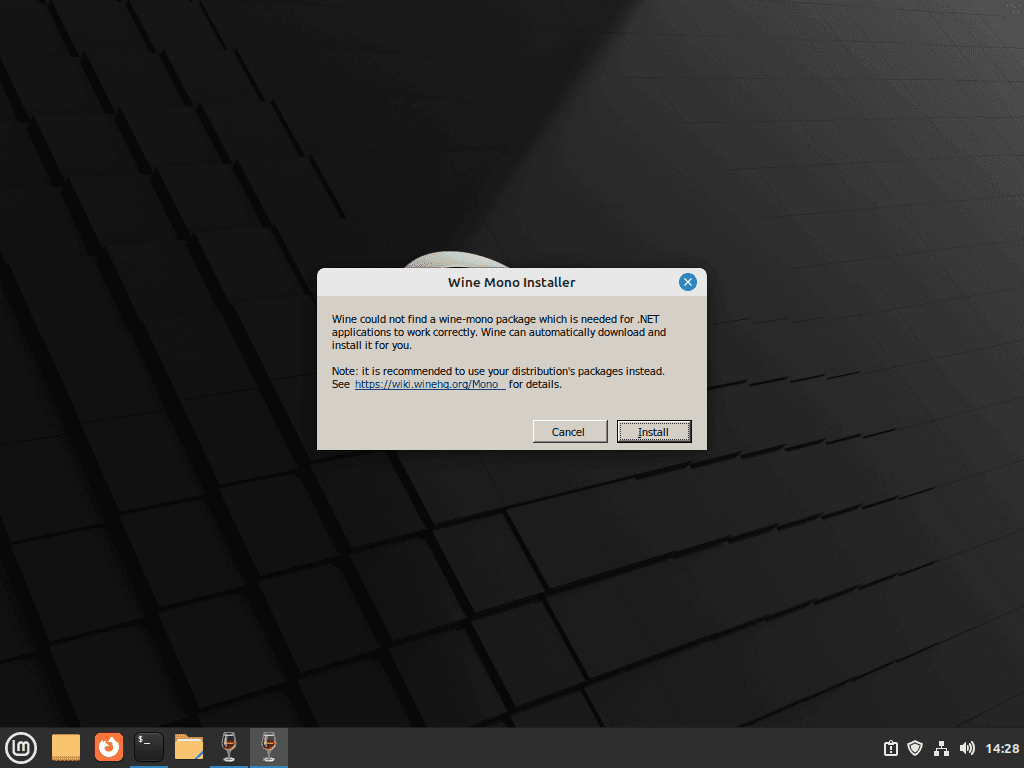
After both prompts complete, verify Mono is present in your Wine prefix:
ls ~/.wine/drive_c/windows/monomono-9.3.0
Similarly, verify Gecko was installed:
ls ~/.wine/drive_c/windows/system32/gecko2.47.4
Both directories confirm the runtimes are ready for .NET and HTML rendering support.
Customize Wine Settings
With the environments installed, the Wine configuration dialog box will open. This interface offers customization options to tailor Wine to your specific needs. For instance, it allows you to select the default Windows version that Wine will emulate. While the default is often set to Windows 7, you can change this to a more recent version like Windows 10, depending on the compatibility requirements of your applications.
The configuration dialog also provides access to various settings tabs, such as audio and graphics. These tabs enable further customization of Wine, allowing you to adjust performance and visual aspects to align with your system’s capabilities and personal preferences. After making any desired changes, close the dialog box to finalize the configuration.
Install Windows Applications with Wine
Download and Open Notepad++ Installer
To begin the installation of Notepad++ on your Linux Mint system using Wine, start by downloading the Notepad++ Windows installer (a .exe file). Choose the version appropriate for your system’s architecture (32-bit or 64-bit).
Once downloaded, navigate to the file location, right-click on the installer, and select Open With Other Application. From the list of applications, choose Wine. This action prompts Wine to execute the installer, similarly to how it would run on a Windows environment.
Complete the Notepad++ Installation
Proceed through the installation wizard as you would on Windows: accept the license agreement, choose your installation directory (or keep the default), and select which components to install. The installer behaves identically to its Windows counterpart, making the process familiar if you’ve installed Windows software before.
Launch Notepad++ from Applications Menu
After installation, Notepad++ appears in your application menu. Search for “Notepad++” on your Linux Mint desktop or browse the menu to locate it. The application runs with full functionality for coding, scripting, and general text editing.
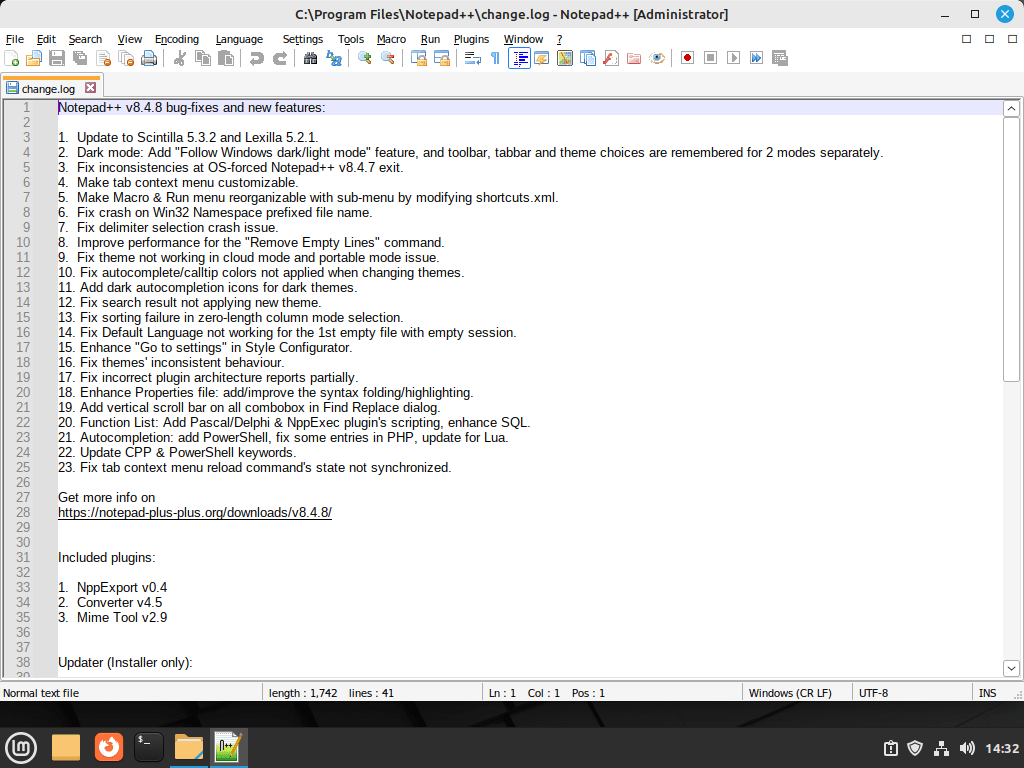
This example demonstrates using Wine to install and run Windows applications like Notepad++ on Linux Mint, expanding the range of tools available to Linux users.
Configure Wine for Gaming and Applications
Install Windows Applications Using Winetricks
Winetricks is a helper script that streamlines the installation of Windows applications and libraries. It simplifies setting up runtime dependencies and specific configurations within Wine.
To install Winetricks, execute:
sudo apt install winetricks -yOnce installed, Winetricks allows for the effortless installation of essential Windows components. For example, to install Microsoft Visual C++ runtime libraries, use:
winetricks vcrun2015Winetricks will download and install the Visual C++ 2015 runtime. The process completes when you see:
------------------------------------------------------ Install of vcrun2015 done
Manage Wine Prefixes
Wine prefixes create isolated environments, enabling you to run applications separately. By default, Wine uses ~/.wine as the primary prefix. However, to create a new, custom prefix, execute:
WINEPREFIX=~/.custom_wine_prefix winecfgReplace ~/.custom_wine_prefix with your chosen directory. This command establishes a new environment and opens its Wine configuration dialog.
Then, verify the new prefix was created:
ls -la ~/.custom_wine_prefixYou should see Wine’s directory structure including dosdevices, drive_c, and system.reg files.
Customizing Wine’s Appearance
To align the appearance of Wine applications with your Linux Mint theme, access the configuration dialog:
winecfgIn the “Desktop Integration” tab, you can customize themes, fonts, and colors to ensure that Wine applications visually integrate with your system.
Improve Gaming Performance with DirectX and DXVK
For applications and games that rely on DirectX, install DirectX libraries and DXVK via Winetricks for enhanced performance. DXVK translates DirectX 10/11 calls to Vulkan, delivering significantly better frame rates on modern Linux systems with Vulkan-capable GPUs.
winetricks d3dx9 d3dx10 d3dx11 dxvkWinetricks will download and configure each component. Upon completion, successful installation shows:
------------------------------------------------------ Install of d3dx9 done Install of d3dx10 done Install of d3dx11 done Install of dxvk done
For DXVK to work properly, ensure your system has Vulkan support. AMD and Intel users should upgrade Mesa drivers on Linux Mint for optimal Vulkan performance. NVIDIA users need the proprietary driver installed.
For serious gaming, consider using Lutris or Steam Proton as Wine-based frontends that automate game-specific Wine configuration and provide one-click installers for popular titles.
Use the Wine Application Database for Compatibility Research
Before installing a Windows application, check the Wine Application Database (AppDB) for compatibility ratings and configuration requirements. The AppDB contains user-submitted test reports showing which Wine versions work best for specific applications and any required workarounds.
To check an application, search for its name on the AppDB homepage. Next, look for the compatibility rating (Platinum, Gold, Silver, Bronze, or Garbage) and read recent test reports for your Wine version. Generally, Gold and Platinum ratings indicate the application works without significant issues. For example, applications with known compatibility include 7-Zip, Sumatra PDF, PuTTY, IrfanView, and many older games that lack native Linux ports.
Wine Administration Commands
Create a 32-bit Wine Prefix
While Wine defaults to supporting 64-bit Windows applications on Linux Mint, you might need to run 32-bit applications. To configure Wine for 32-bit applications, set a new environment with these commands:
export WINEARCH=win32
export WINEPREFIX=~/.wine32
winecfgThese commands establish a new Wine prefix exclusively for 32-bit applications and open the Wine configuration dialog for that specific prefix.
Run Windows Executables from Terminal
Wine can be operated directly from the terminal, providing a quick method to launch Windows applications. The command structure is:
wine PROGRAM [ARGUMENTS...]For example, to execute a Windows application, such as example_app.exe, enter:
wine example_app.exeThis method is efficient for running Windows applications without needing a graphical interface.
Update Wine
Update Wine regularly to receive compatibility improvements, bug fixes, and security patches. Simply use standard APT commands to update Wine alongside other system packages:
sudo apt update && sudo apt upgrade -yThis command refreshes the package list and installs available updates from the WineHQ repository and other configured sources.
Remove Wine
Should you need to uninstall Wine, select the command that corresponds to your installed version:
sudo apt remove winehq-stablesudo apt remove winehq-stagingsudo apt remove winehq-develFor a complete removal including the repository and GPG key:
sudo rm /etc/apt/sources.list.d/winehq.sources
sudo rm /usr/share/keyrings/winehq.gpgOptionally, remove your Wine configuration directory to delete all installed Windows applications and settings:
rm -rf ~/.wineUpdate the package cache after removing the repository:
sudo apt updateTroubleshoot Common Wine Issues
Missing 32-bit Library Dependencies
Many Windows applications require 32-bit libraries even on 64-bit Linux Mint systems. If applications fail to launch with library errors, enable 32-bit architecture support and install missing dependencies.
Error:
wine: Call from 00007B7CE7A09F66 to unimplemented function api-ms-win-core-path-l1-1-0.dll.PathCchRemoveBackslash 0024:err:module:import_dll Library libFAudio.so.0 (which is needed by L"C:\\windows\\system32\\winex11.drv") not found
Diagnostic:
dpkg --print-foreign-architecturesIf this returns nothing, then 32-bit support is not enabled.
Fix:
sudo dpkg --add-architecture i386
sudo apt update
sudo apt install libfaudio0:i386 -yVerification:
dpkg --print-foreign-architecturesi386
Application Crashes with DirectX Errors
Games and graphics-intensive applications often fail when DirectX libraries are missing or outdated. Install DirectX components through Winetricks to resolve rendering and initialization errors.
Error:
Application requires DirectX 9.0c or later failed to initialize graphics subsystem
Diagnostic:
Check which DirectX libraries are currently installed in your Wine prefix:
ls ~/.wine/drive_c/windows/system32/d3d*A minimal output with only a few files indicates missing DirectX components.
Fix:
sudo apt install winetricks -y
winetricks d3dx9 d3dx10 d3dx11 dxvkThe dxvk component translates DirectX 10/11 calls to Vulkan for improved performance on modern Linux systems.
Verification:
ls ~/.wine/drive_c/windows/system32/d3dx9*.dll | wc -l24
A count of 24 or more DirectX 9 DLLs confirms successful installation.
Audio Not Working in Wine Applications
Audio issues typically stem from missing PulseAudio or ALSA libraries. Install the appropriate audio backend for your Linux Mint configuration.
Diagnostic:
winecfgNavigate to the Audio tab and check if any drivers are listed. If the dropdown is empty, then audio libraries are missing.
Fix:
sudo apt install libpulse0:i386 libasound2:i386 libasound2-plugins:i386 -yVerification:
Open winecfg, navigate to Audio, and verify PulseAudio or ALSA appears in the driver list. Click Test Sound to confirm audio output.
Wine Prefix Corruption
Failed installations or incompatible application updates can corrupt Wine prefixes. Reset the default prefix or create a clean isolated environment to resolve this.
Error:
wine: configuration in '/home/user/.wine' has been updated Segmentation fault (core dumped)
Diagnostic:
Test whether Wine can initialize the prefix correctly:
WINEDEBUG=-all wine cmd /c echo test 2>&1If this produces errors or crashes instead of printing “test”, the prefix is corrupted.
Fix (reset default prefix):
mv ~/.wine ~/.wine.backup
winecfgThis renames the corrupted prefix and initializes a fresh environment. However, your applications will need reinstallation, but configuration corruption is resolved.
Alternative (create isolated prefix):
WINEPREFIX=~/.wine-clean winecfgThis creates a separate Wine environment at ~/.wine-clean without affecting your default prefix. Use this pattern to isolate problematic applications from your main Wine configuration.
Verification:
wine --version && ls ~/.wine/drive_c/windows/system32/*.dll | head -5A successful Wine version output followed by a list of system DLLs confirms the prefix was recreated correctly.
Conclusion
You have installed Wine on Linux Mint using the WineHQ repository, configured Mono and Gecko runtimes for .NET and web browser support, and learned to manage Wine prefixes for application isolation. Use Winetricks to install additional Windows components when applications require DirectX or Visual C++ runtimes, and consult the troubleshooting section when encountering library dependency or audio issues.
For gaming, install Steam on Linux Mint to access Proton, which provides Wine-based compatibility for thousands of Windows games. If you plan to run graphics-intensive applications or games with DXVK, ensure you have NVIDIA drivers installed for Vulkan support. Check the Wine Application Database for compatibility reports and configuration tweaks specific to your Windows applications, and refer to the official Wine documentation for advanced prefix management and debugging techniques.

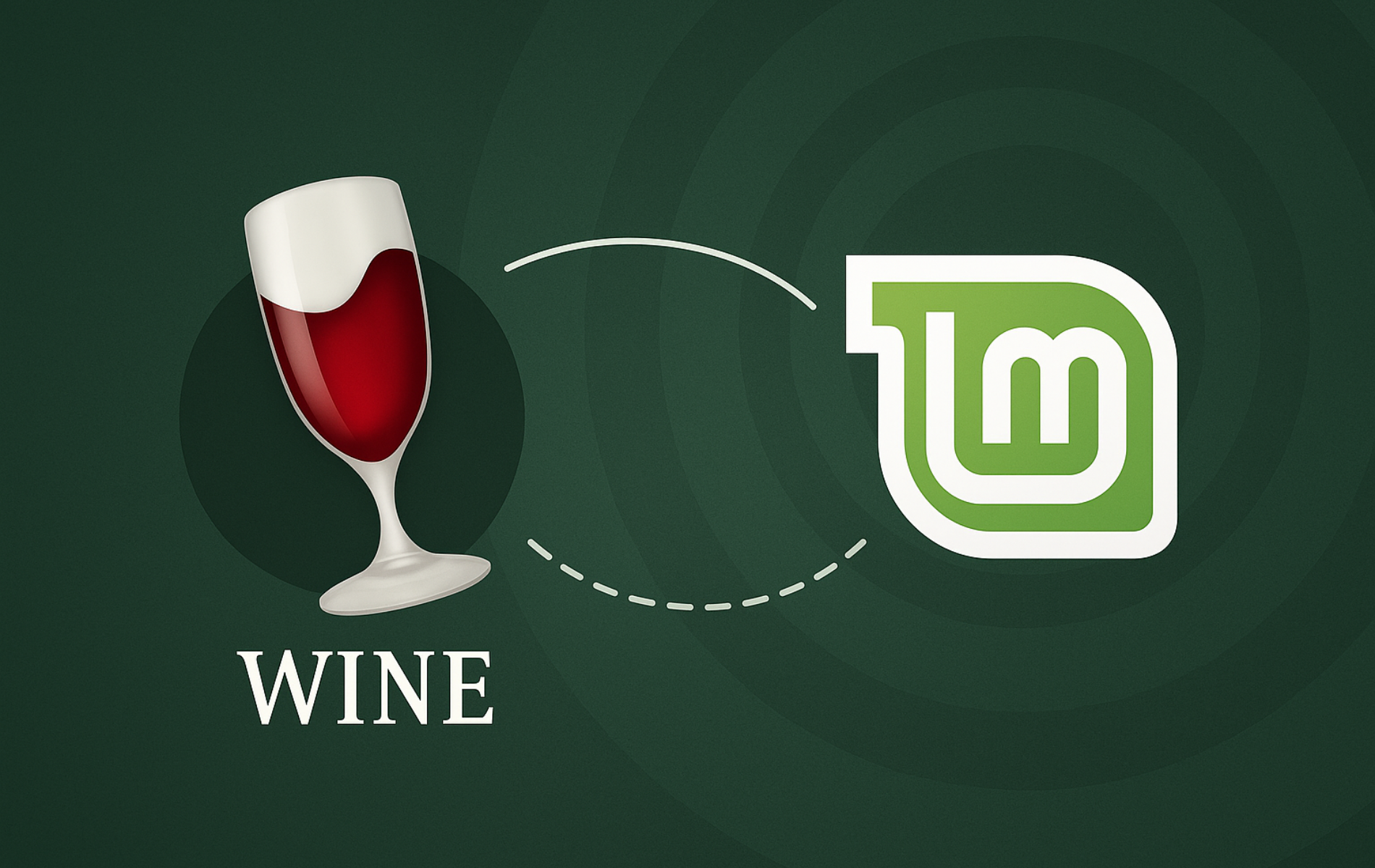
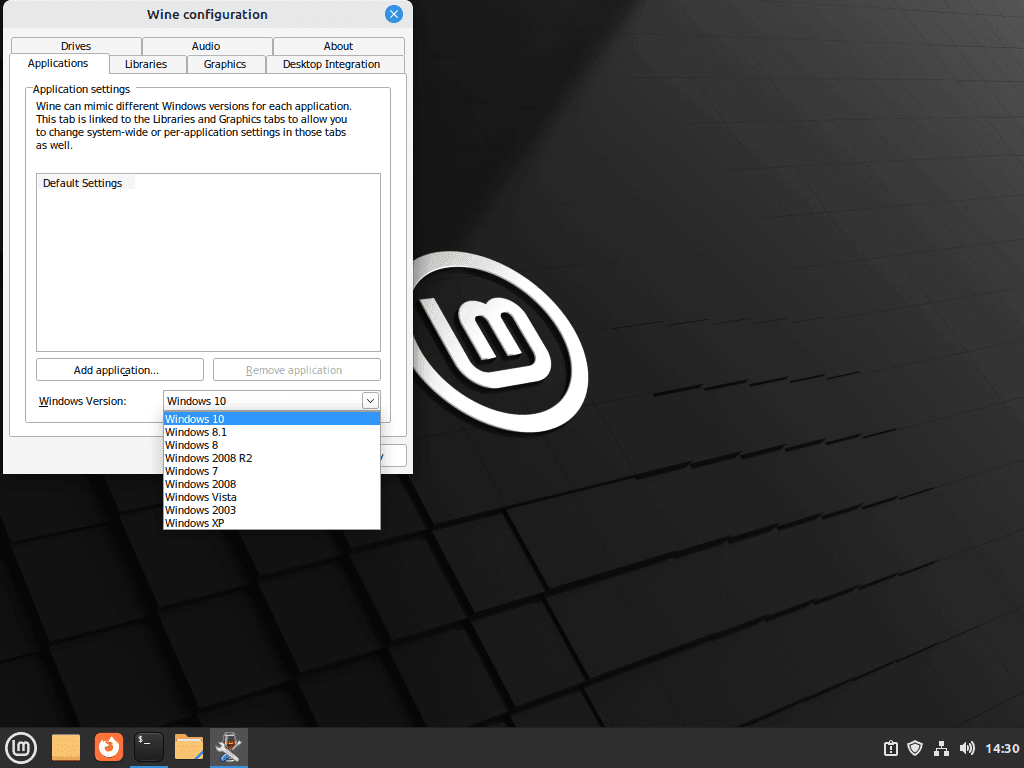
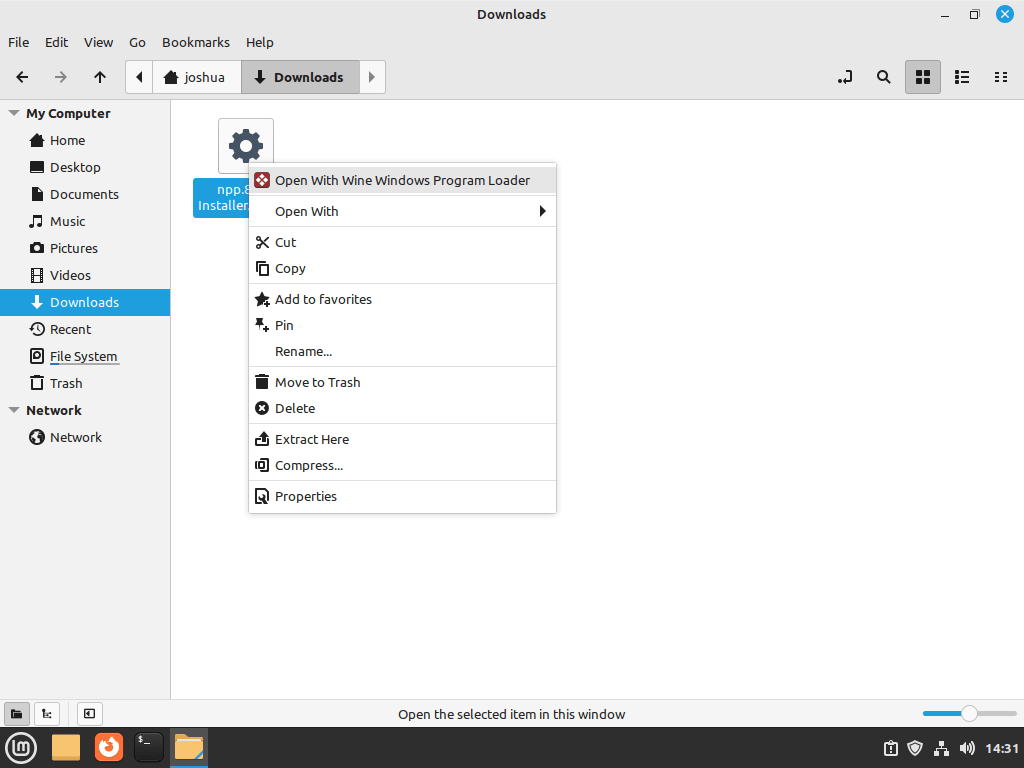

Everything worked perfectly, tested with 123freesolitaire.exe.
But now I’m stuck with Evernote.
Thanks for confirming the installation worked, Barny. Glad 123freesolitaire.exe ran successfully.
For Evernote, try launching the installer with
wine EvernoteSetup.exefrom the directory containing the file. If it fails, check the terminal output for missing dependencies. Evernote often needswinetricks corefontsandwinetricks vcrun2015for .NET components. Run those commands, then retry the installer. If you are still stuck, share the specific error message and I can help troubleshoot further.Thank you for your help; following your clear instructions it worked well.
I do not understand the YouTube posts as the definition of their movies is not clear and there is no way to copy and past to Terminal. Mint 22.1
Thanks again Peter
Thanks for the kind words, Peter. Glad the guide worked well for you on Mint 22.1.
You make a great point about video tutorials. Written guides let you copy commands directly, pause at your own pace, and search for specific steps instantly. Videos force you to pause, squint, and manually type commands while hoping you did not miss a character. That is exactly why LinuxCapable focuses on text-based tutorials with copy-paste ready code blocks.
The command ‘echo deb [signed-by=/usr/share/keyrings/winehq.gpg] http://dl.winehq.org/wine-builds/ubuntu/ noble main#’
It just prints ‘deb [signed-by=/usr/share/keyrings/winehq.gpg] http://dl.winehq.org/wine-builds/ubuntu/ noble main#’ right under the same command and does NOT do anything else.
Thanks for reporting this, pooky2483. The
echocommand by itself just prints to the screen. It needs output redirection to create the file.The current guide uses the DEB822 format with proper redirection. Run this command block for Linux Mint 22.x:
For Linux Mint 21.x, use
jammyinstead ofnoblein the Suites line. The guide includes complete instructions for both versions with the correct repository format.This is THE MOST comprehensive ‘how to’ that I have been fortunate enough to come across.
The steps are not only easy to follow, but explained as to how and why they are done. Have had and ongoing battle with WINE for too long now, this tutorial solved it all. Heading over to the Virtual Box install now.
Thank you so much.
Running Mint 21.3. Instructions failed right from the start. Ran the command: sudo apt install dirmngr ca-certificates software-properties-common apt-transport-https and received this message
“E: Unable to locate package dirmgr” I then did a repository search (sudo apt-cache search dirmgr) and did not get any hits.
I had a previous version of WineHQ on this machine before a hard drive failure last year. Can’t seem to reinstall it since changing the HD and reloading Mint.
I am just a beginner here, but maybe I can help. It looks like your command has ‘dirmngr’ while the response message has ‘dirmgr’. Could you be dealing with a typo?
Thanks for catching that typo, Wayne. You were absolutely right. The article had
dirmgrinstead ofdirmngrwhen you commented in January. The command has since been corrected to:After running the corrected command, continue with enabling 32-bit architecture support and importing the WineHQ repository key. If you are still having issues after the hard drive replacement, verify that your sources are clean by checking /etc/apt/sources.list.d/ for any old WineHQ entries from your previous installation that might be conflicting.